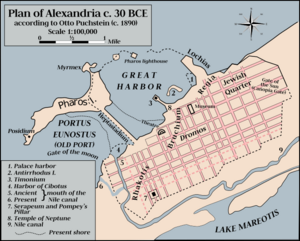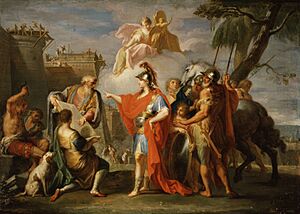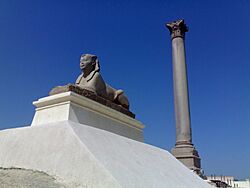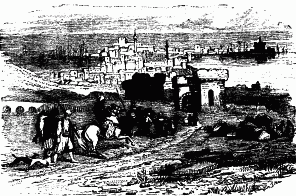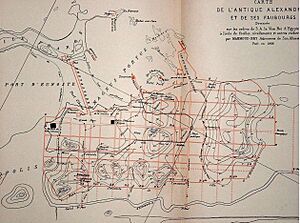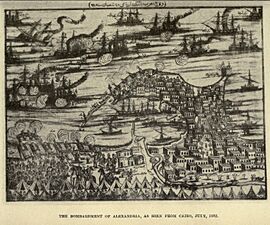History of Alexandria facts for kids
The history of Alexandria dates back to the city's founding, by Alexander the Great, in 331 BC. Yet, before that, there were some big port cities just east of Alexandria, at the western edge of what is now Abu Qir Bay. The Canopic (westernmost) branch of the Nile Delta still existed at that time, and was widely used for shipping.
After its foundation, Alexandria became the seat of the Ptolemaic Kingdom, and quickly grew to be one of the greatest cities of the Hellenistic world. Only Rome, which gained control of Egypt in 30 BC, eclipsed Alexandria in size and wealth.
The city fell to the Arabs in AD 641, and a new capital of Egypt, Fustat, was founded on the Nile. After Alexandria's status as the country's capital ended, it fell into a long decline, which by the late Ottoman period, had seen it reduced to little more than a small fishing village. The French army under Napoleon captured the city in 1798 and the British soon captured it from the French, retaining Alexandria within their sphere of influence for 150 years. The city grew in the early 19th century under the industrialization program of Mohammad Ali, the viceroy of Egypt.
The current city is the Republic of Egypt's leading port, a commercial, tourism and transportation center, and the heart of a major industrial area where refined petroleum, asphalt, cotton textiles, processed food, paper, plastics and styrofoam are produced.
Contents
Early settlements in the area
Just east of Alexandria in ancient times (where now is Abu Qir Bay) there was marshland and several islands. As early as the 7th century BC, there existed important port cities of Canopus and Heracleion. The latter was recently rediscovered under water. Part of Canopus is still on the shore above water, and had been studied by archaeologists the longest. There was also the town of Menouthis. The Nile Delta had long been politically significant as the point of entry for anyone wishing to trade with Egypt.
An Egyptian city or town, Rhakotis, existed on the shore where Alexandria is now. Behind it were five villages scattered along the strip between Lake Mareotis and the sea, according to the Romance of Alexander.
Foundation
Alexandria was founded by Alexander the Great in 331 BC (the exact date is disputed) as Ἀλεξάνδρεια (Aleksándreia). Alexander's chief architect for the project was Dinocrates. Ancient accounts are extremely numerous and varied, and much influenced by subsequent developments. One of the more sober descriptions, given by the historian Arrian, tells how Alexander undertook to lay out the city's general plan, but lacking chalk or other means, resorted to sketching it out with grain. A number of more fanciful foundation myths are found in the Alexander Romance and were picked up by medieval historians.
A few months after the foundation, Alexander left Egypt for the East and never returned to his city. After Alexander departed, his viceroy, Cleomenes, continued the expansion of the city.
In a struggle with the other successors of Alexander, his general, Ptolemy (later Ptolemy I of Egypt) succeeded in bringing Alexander's body to Alexandria. Alexander's tomb became a famous tourist destination for ancient travelers (including Julius Caesar). With the symbols of the tomb and the Lighthouse, the Ptolemies promoted the legend of Alexandria as an element of their legitimacy to rule.
Alexandria was intended to supersede Naucratis as a Hellenistic center in Egypt, and to be the link between Greece and the rich Nile Valley. If such a city was to be on the Egyptian coast, there was only one possible site, behind the screen of the Pharos island and removed from the silt thrown out by the Nile, just west of the westernmost "Canopic" mouth of the river. At the same time, the city could enjoy a fresh water supply by means of a canal from the Nile. The site also offered unique protection against invading armies: the vast Libyan Desert to the west and the Nile Delta to the east.
Though Cleomenoes was mainly in charge of seeing to Alexandria's continuous development, the Heptastadion (causeway to Pharos Island) and the main-land quarters seem to have been mainly Ptolemaic work. Demographic details of how Alexandria rose quickly to its great size remain unknown.
Ptolemaic era
Inheriting the trade of ruined Tyre and becoming the center of the new commerce between Europe and the Arabian and Indian East, the city grew in less than a generation to be larger than Carthage. In a century, Alexandria had become the largest city in the world, and for some centuries more, was second only to Rome. It became the main Greek city of Egypt, with an extraordinary mix of Greeks from many cities and backgrounds. Nominally a free Hellenistic city, Alexandria retained its senate of Roman times and the judicial functions of that body were restored by Septimius Severus after temporary abolition by Augustus.
Construction
Monumental buildings were erected in Alexandria through the third century BC. The Heptastadion connected Pharos with the city and the Lighthouse of Alexandria followed soon after, as did the Serapeum, all under Ptolemy I. The Museion was built under Ptolemy II; the Serapeum expanded by Ptolemy III Euergetes; and mausolea for Alexander and the Ptolemies built under Ptolemy IV.
Library of Alexandria
The Ptolemies fostered the development of the Library of Alexandria and associated Musaeum into a renowned center for Hellenistic learning.
Luminaries associated with the Musaeum included the geometry and number-theorist Euclid; the astronomer Hipparchus; and Eratosthenes, known for calculating the Earth's circumference and for his algorithm for finding prime numbers, who became head librarian.
Strabo lists Alexandria, with Tarsus and Athens, among the learned cities of the world, observing also that Alexandria both admits foreign scholars and sends its natives abroad for further education.
Ethnic divisions
The early Ptolemies were careful to maintain the distinction of its population's three largest ethnicities: Greek, Jewish, and Egyptian. (At first, Egyptians were probably the plurality of residents, while the Jewish community remained small. Slavery, a normal institution in Greece, was likely present but details about its extent and about the identity of slaves are unknown.) Alexandrian Greeks placed an emphasis on Hellenistic culture, in part to exclude and subjugate non-Greeks.
The law in Alexandria was based on Greek—especially Attic—law. There were two institutions in Alexandria devoted to the preservation and study of Greek culture, which helped to exclude non-Greeks. In literature, non-Greek texts entered the library only once they had been translated into Greek. Notably, there were few references to Egypt or native Egyptians in Alexandrian poetry; one of the few references to native Egyptians presents them as "muggers." There were ostentatious religious processions in the streets that displayed the wealth and power of the Ptolemies, but also celebrated and affirmed Greekness. These processions were used to shout Greek superiority over any non-Greeks that were watching, thereby widening the divide between cultures.
From this division arose much of the later turbulence, which began to manifest itself under the rule of Ptolemy Philopater (221–204 BC). The reign of Ptolemy VIII Physcon from 144–116 BC was marked by purges and civil warfare (including the expulsion of intellectuals such as Apollodorus of Athens), as well as intrigues associated with the king's wives and sons.
Alexandria was also home to the largest Jewish community in the ancient world. The Septuagint, a Greek translation of the Hebrew Bible (the Torah and other writings), was produced there. Jews occupied two of the city's five quarters and worshipped at synagogues.
Roman era
Roman annexation
Having been under Roman influence for more than a hundred years, the city was placed formally within Roman jurisdiction by the will of Ptolemy Alexander in 80 BC. Julius Caesar dallied with Cleopatra in Alexandria in 47 BC and was besieged in the city by Cleopatra's brother and rival. His example was followed by Mark Antony, for whose favor the city paid dearly to Octavian. Following Antony's defeat at the Battle of Actium, Octavian took Egypt as personal property of the emperor, appointing a prefect who reported personally to him rather than to the Roman Senate.

From the time of annexation and onwards, Alexandria seemed to have regained its old prosperity, commanding, as it did, an important granary of Rome. This was one of the chief reasons that induced Octavian to place it directly under imperial power.
Jewish–Greek ethnic tensions in the era of Roman administration led to riots in AD 38 and again in 66. Buildings were burned during the Kitos War (Tumultus Iudaicus) of AD 115, giving Hadrian and his architect, Decriannus, an opportunity to rebuild.
In 215 AD the emperor Caracalla visited the city and, because of some insulting satires that the inhabitants had directed at him, abruptly commanded his troops to put to death all youths capable of bearing arms. This brutal order seems to have been carried out even beyond the letter, for a general massacre ensued. According to historian Cassius Dio, over 20,000 people were killed.
In the 3rd century AD, Alexander's tomb was closed to the public, and now its location has been forgotten.
Late Roman and Byzantine period
Even as its main historical importance had sprung from pagan learning, Alexandria now acquired new importance as a center of Christian theology and church government. There, Arianism came to prominence, and there also Athanasius opposed Arianism and the pagan reaction against Christianity, experiencing success against both and continuing the Patriarch of Alexandria's major influence on Christianity into the next two centuries.
Persecution of Christians under Diocletian (beginning in AD 284) marks the beginning of the Era of Martyrs in the Coptic calendar.
As native influences began to reassert themselves in the Nile valley, Alexandria gradually became an alien city, more and more detached from Egypt and losing much of its commerce as the peace of the empire broke up during the 3rd century, followed by a fast decline in population and splendor.
In 365, a tsunami caused by an earthquake in Crete hit Alexandria.
In the late 4th century, persecution of pagans by Christians had reached new levels of intensity. Temples and statues were destroyed throughout the Roman empire: pagan rituals became forbidden under punishment of death, and libraries were closed. In 391, Emperor Theodosius I ordered the destruction of all pagan temples, and the Patriarch Theophilus complied with his request. The Serapeum of the Great Library was destroyed, possibly effecting the final destruction of the Library of Alexandria. The neoplatonist philosopher Hypatia was publicly murdered by a Christian mob.
The Brucheum and Jewish quarters were desolate in the 5th century, and the central monuments, the Soma and Museum, fell into ruin. On the mainland, life seemed to have centered in the vicinity of the Serapeum and Caesareum, both which became Christian churches. The Pharos and Heptastadium quarters, however, remained populous and were left intact.
Recent archaeology at Kom El Deka (heap of rubble or ballast) has found the Roman quarter of Alexandria beneath a layer of graves from the Muslim era. The remains found at this site, which are dated circa the fourth to seventh centuries AD, include workshops, storefronts, houses, a theater, a public bath, and lecture halls, as well as Coptic frescoes. The baths and theater were built in the fourth century and the smaller buildings constructed around them, suggesting a sort of urban renewal occurring in the wake of Diocletian.
Arab rule

In 619, the city was taken by Khosrau II, King of Persia. Although the Byzantine Emperor Heraclius recovered it a few years later, in 641 the Arabs, under the general Amr ibn al-As during the Muslim conquest of Egypt, captured it decisively after a siege that lasted fourteen months. The city received no aid from Constantinople during that time; Heraclius was dead and the new Emperor Constans II was barely twelve years old. In 645 a Byzantine fleet recaptured the city, but it fell for good the following year. Thus ended a period of 975 years of the Greco-Roman control over the city. Nearly two centuries later, between the years 814 and 827, Alexandria came under the control of pirates of Andalusia (Spain today), later to return to Arab hands. In the year 828, the alleged body of Mark the Evangelist was stolen by Venetian merchants, which led to the Basilica of Saint Mark. Years later, the city suffered many earthquakes during the years 956, 1303 and then in 1323. After a long decline, Alexandria emerged as major metropolis at the time of the Crusades and lived a flourishing period due to trade with agreements with the Aragonese, Genoese and Venetians who distributed the products arrived from the East through the Red Sea. It formed an emirate of the Ayyubid Empire, where Saladin's elder brother Turan Shah was granted a sinecure to keep him from the front lines of the crusades. In the year 1365, Alexandria was brutally sacked after being taken by the armies of the Crusaders, led by King Peter of Cyprus. The fourteenth and fifteenth centuries, Venice has eliminated the jurisdiction and its Alexandrian warehouse became the center of the distribution of spices to the Portuguese Cape route to open in 1498, which marks the commercial decline, worsened by the Turkish invasion.
There has been a persistent belief that the Library of Alexandria and its contents were destroyed in 642 during the Arab invasion.
The Lighthouse was destroyed by earthquakes in the 14th century, and by 1700 the city was just a small town amidst the ruins.
Though smaller, the city remained a significant port for Mediterranean trade well through the medieval period, under the Mamluk sultanate, playing a part in the trade network of Italian city-states. However, it declined still further under the Ottoman Empire, losing its water supply from the Nile, and its commercial importance, as Rosetta (Rashid) became more useful as a port.
Modern history
Napoleonic invasion
Alexandria figured prominently in the military operations of Napoleon's expedition to Egypt in 1798. French troops stormed the city on July 2, 1798 and it remained in their hands until the British victory at the Battle of Alexandria on March 21, 1801, following which the British besieged the city which fell to them on 2 September 1801.
Two French savants assessing the population of Alexandria in 1798 estimated 8,000 and 15,000.
Muhammad Ali
Muhammad Ali, the Ottoman Governor of Egypt, began rebuilding the city around 1810, and by 1850, Alexandria had returned to something akin to its former glory.
British occupation
In July 1882 the city was the site of the first battle of the Anglo-Egyptian War, when it was bombarded and occupied by the Royal Navy. Large sections of the city were damaged in the battle, or destroyed in subsequent fires.
Republic of Egypt
Relations between Egypt and the United Kingdom grew strained in the 1950s, with violence periodically erupting between local police units and the British Army, in Alexandria as well as in Cairo. These clashes culminated in the Egyptian coup of 1952, during which the army occupied Alexandria and drove King Farouk from his residence at Montaza Palace.
In July 1954, the city was a target of an Israeli bombing campaign that later became known as the Lavon Affair. Only a few months later, Alexandria's Manshia Square was the site of the famous, failed assassination attempt on the life of Gamal Abdel Nasser.
Mayors of Alexandria (since the implementation of the local-government act of 1960):
- Siddiq Abdul-Latif (October 1960 - November 1961)
- Mohammed Hamdi Ashour (November 1961 - October 1968)
- Ahmad Kamil (October 1968 - November 1970)
- Mamdouh Salim (November 1970 - May 1971)
- Ahmad Fouad Mohyee El-Deen (May 1971 - September 1972)
- Abdel-Meneem Wahbi (September 1972 - May 1974)
- Abdel-Tawwab Ahmad Hadeeb (May 1974 - November 1978)
- Mohammed Fouad Helmi (November 1978 - May 1980)
- Naeem Abu-Talib (May 1980 - August 1981)
- Mohammed Saeed El-Mahi (August 1981 - May 1982)
- Mohammed Fawzi Moaaz (May 1982 - June 1986)
- Ismail El-Gawsaqi (July 1986 - July 1997)
- Abdel-Salam El-Mahgoub (1997–2006)
- Adel Labib (August 2006 - )
Arts
Alexandria was the home of the ethnically Greek poet Constantine P. Cavafy. E. M. Forster, who worked in Alexandria for the International Red Cross during World War I, wrote two books about the city and promoted Cavafy's work.
Lawrence Durrell, working for the British in Alexandria during World War II, achieved international success with the publication of The Alexandria Quartet (1957–1960).
Recent discoveries
In July 2018, archaeologists led by Zeinab Hashish announced the discovery of a 2,000-year-old 30-ton black granite sarcophagus. It contained three damaged skeletons in red-brown sewage water. According to archaeologist Mostafa Waziri, the skeletons looked like a family burial with a middle-aged woman and two men. Researchers also revealed a small gold artifact and three thin sheets of gold.
In June 2022, archaeologists from The Cairo Ministry of Antiquities announced the discovery of an alabaster bust of Alexander the Great as well as molds and other materials for creating amulets for warriors and for statues of Alexander the Great.
See also
- Timeline of Alexandria


